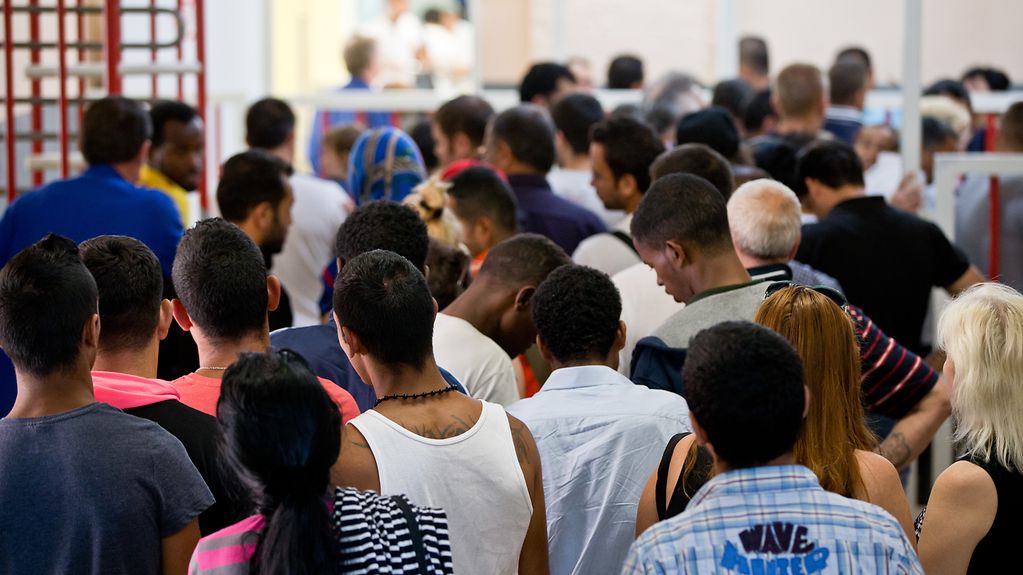Global Compact for Migration
With the Global Compact for Safe, Orderly and Regular Migration, the international community aims for the first time to find shared, global solutions to the phenomenon of migration. The aim is to reduce illegal migration and strengthen legal migration. On Thursday, the German Bundestag welcomed the Global Compact, which is to be adopted at a UN conference on 10 and 11 December.
3 min reading time

The Global Compact for Migration calls on all countries to protect migrants
Photo: picture alliance / dpa
The Global Compact for Safe, Orderly and Regular Migration underscores the shared will of the international community to accept responsibility for better steering and ordering global migration.
The Global Compact for Migration was initiated and elaborated by the United Nations. It lays solid foundations for extensive international cooperation – at global level. It specifically covers the wide spectrum of migrants – but not refugees.
On 10 and 11 December 2018 the Global Compact is to be adopted at an Intergovernmental Conference in Marrakesh (Morocco). It will then be formally adopted by the UN General Assembly. On Thursday, the German Bundestag welcomed the fact that the international community has elaborated the Global Compact for Safe, Orderly and Regular Migration.
In July 2018, about 192 member states of the United Nations finally agreed on the wording of the Global Compact for Migration after intensive discussions. The Global Compact has its roots in the New York Declaration of September 2016.
Safe, orderly migration
The Global Compact for Migration aims to foster safe, orderly and legal migration within the international framework.
At the same time it provides for reducing illegal migration as a whole.
It makes a clear commitment to securing borders and to the obligation of all states to readmit their own citizens if they are found to be residing unlawfully in another state.
The Global Compact calls on all states to address the root causes of illegal migration and motivates them to fight networks of smugglers and human traffickers. Transit states and countries of origin have a special duty in this context, it says.
Concrete objectives and measures
Alongside political objectives, the Global Compact specifies about 23 concrete measures that are to be taken in order to achieve the objectives.
They include the use of biometric identification to facilitate cooperation with countries of origin and facilitate the readmission of migrants.
The establishment of a global migration database is also envisaged, to put political debate about migration on a factual basis.
Protecting migrants
The Global Compact for Migration calls on all countries to protect migrants. They are to enhance the precarious situation in which migrants find themselves by treating them with dignity.
The goal is to address the problem of poor living conditions, because it is often the poor conditions in countries of origin and transit states that drive illegal migration.
Not legally binding
The Global Compact is not a legally binding treaty, but it does send a strong political message and it is in the interests of Germany.
The national sovereignty of signatory states on border and security issues is specifically not affected. Their right to deem illegal entry to the country a potentially criminal offence likewise is not affected.
The Global Compact thus fosters existing paths of steered legal migration without extending immigration opportunities.
The legalisation of illegal migrants is only recommended where this is in the public interest of the target country.
Migration - a global phenomenon
The German government has been working for some time to address the challenges posed by migration as a global phenomenon within the framework of Europe and at international level, and to find effective solutions.
That is why Germany has been very actively involved in the negotiations that led to the Global Compact since the outset with its EU partners.
For the first time ever, the Global Compact brings together countries of origin, transit states and target countries in joint efforts to resolve migration issues.
It thus sends an important message about the need to find coordinated, multilateral solutions to global challenges.
In addition to the Global Compact for Migration, a separate Global Compact on Refugees will be put before the United Nations General Assembly for adoption in December 2018. Like the Global Compact for Migration it is not legally binding, and is also based on the 2016 New York Declaration. While the Global Compact for Migration was elaborated by the United Nations, the Global Compact on Refugees was drafted under the aegis of the UN Refugee Agency (UNHCR).